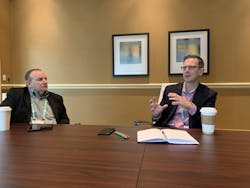In 2015, Emerson repositioned its portfolio of technologies and services around two business platforms—Commercial & Residential Solutions and Automation Solutions. Obviously, our interest is in the Automation Solutions division, formerly known as Emerson Process Management. This change in name has proven to be more than just a corporate branding initiative. It’s a message of intent surrounding Emerson’s role as an automation technology supplier.
This new direction for Emerson became more evident in 2017 when Emerson made bids to acquire Rockwell Automation. Though this acquisition attempt did not pan out, just a year later the company acquired GE Intelligent Platforms—giving Emerson access to an array of discrete industry automation technologies.
Considering Emerson’s long history as a process industry-oriented company, Automation World met with Peter Zornio (pictured at left in image accompanying this article), Emerson’s CTO, and Stuart Harris, group president of Emerson’s new Digital Transformation business, to get a better understanding of the company’s changing position in the industrial automation market.
“This is a conscious effort to expand into discrete industries,” said Zornio, describing how Emerson’s repositioning in 2015 provided the company an opportunity to “focus on automation” and enable it to serve “as big a space as possible.” He noted that Emerson’s discrete industry technology acquisitions are part of a two-fold strategy to “build discrete solutions aimed at factory automation and take them into hybrid manufacturing. We’re not going to ignore bringing that [discrete technologies] into process and hybrid.”
“From a business point of view, our strengths have been in the process and hybrid industries,” added Harris. “But we’ve interfaced with PLCs for a long time around specific applications, such as high-speed control. Having the GE PLC gives us a control platform in the discrete space. We see this (the GE Intelligent Platforms acquisition) as an opportunity to connect islands of automation.” He also noted that Emerson’s recent acquisition of Aventics, along with the company’s acquisition of ASCO in 1985, have also provided the company with a number of instrumentation technologies for the discrete industries.
Zornio pointed out that the two worlds of industry (process and discrete) are becoming more technologically close than they were 30 years ago. This reality is behind Emerson plan to bring PLC control into its DeltaV distributed control system (DCS) for applications such as compressor control.
When it comes to approaching control from a process or discrete automation point of view, Zornio said, “the biggest difference is in the software design. Are you designing a system from the beginning to have everything in an integrated suite that can’t be taken apart easily? If so, that’s a DCS with a single database. Discrete automation is the opposite, where best in class components—such as controls and historians—are selected and then knitted together. We broke the mold in this area with the DeltaV PK controller, as this controller can be part of an integrated DCS suite or be taken out of the DCS and run stand-alone on a machine.”
Zornio noted that, as important as DCS technology is to the process industries, “90% of control in a refinery is not done in a DCS. They have lots of packaged units that use PLCs, like the PK controller.”
The fact that refineries don’t need high-speed motion controls is a big reason why the PK controller was not developed to address applications such as robotics or high-speed packaging applications. This capability gap, coupled with Emerson’s intent to broaden its reach into the batch and discrete industries, was a factor behind Emerson’s acquisition of GE Intelligent Platforms.
Further explaining the broadening of Emerson’s reach as a technology supplier, Zornio said there are two major shifts the company is focusing on: expanding its presence in the automation space and Digital Transformation. “At its core, Digital Transformation—and the creation of the Emerson business focused on this—is putting us into different space. This is more software oriented and incorporates pervasive sensing, but it’s also more app oriented around things like reliability, safety, and energy use. So, in some ways, it was more natural for us to expand horizontally in automation (as the company did with its GE Intelligent Platforms acquisition); the bigger leap for us is into software, data integration, and connection with ERP systems.”
Facing the growth required by Emerson to play in the bigger automation space it’s targeting, Harris observed that Emerson’s PlantWeb architecture, first introduced in 1997, already addresses “many of these [digital transformation] concepts around instrumentation and rotating equipment. Now were looking to handle that information with analytics in the cloud; so, it’s new and different, but also just an extension of what we already had. It really gives us a chance to more fully capitalize on what we’ve long been doing.”
Leaders relevant to this article:


